Online marketplace Etsy (NASDAQ:ETSY) reported results in line with analysts' expectations in Q1 CY2024, with revenue flat year on year at $646 million. It made a GAAP profit of $0.48 per share, down from its profit of $0.52 per share in the same quarter last year.
Etsy (ETSY) Q1 CY2024 Highlights:
- Revenue: $646 million vs analyst estimates of $646.5 million (small miss)
- EPS: $0.48 vs analyst expectations of $0.49 (1.2% miss)
- Gross Margin (GAAP): 71%, up from 69.5% in the same quarter last year
- Free Cash Flow of $59.32 million, down 79% from the previous quarter
- Active Buyers: 96.39 million, up 866,000 year on year
- Market Capitalization: $8.05 billion
Founded by a struggling amateur furniture maker Robert Kalin and his two friends, Etsy (NASDAQ:ETSY) is one of the world’s largest online marketplaces, focusing on handmade or vintage items.
Etsy operates a two-sided online marketplace that connects tens of millions of buyers and sellers around the world with a focus on unique and creative goods that are crafted and curated by individuals or small businesses. Most of its products are in six main categories: home furnishings, jewelry, craft supplies, apparel, paper & party supplies, and beauty & personal care. The company is asset lite: it owns no warehouses, takes no inventory risk, and does not operate a supply chain network.
Etsy offers a differentiated value proposition for its sellers and its buyers. For buyers, it has created a very successful niche to find custom and curated items, from special purpose gifts to everyday items that have added meaning. For sellers, Etsy provides a large global audience for their merchandise, while also offering a range of tools and analytics to manage their online businesses.
Online Marketplace
Marketplaces have existed for centuries. Where once it was a main street in a small town or a mall in the suburbs, sellers benefitted from proximity to one another because they could draw customers by offering convenience and selection. Today, a myriad of online marketplaces fulfill that same role, aggregating large customer bases, which attracts commission-paying sellers, generating flywheel scale effects that feed back into further customer acquisition.
Etsy (NASDAQ:ETSY) competes with a range of ecommerce companies such as Amazon (NASDAQ:AMZN), Walmart (NYSE:WMT), Shopify (NASDAQ:SHOP), and eBay (NASDAQ:EBAY), and increasingly with social commerce companies like Pinterest (NYSE:PINS), and Meta Platforms (NASDAQ:META).
Sales Growth
Etsy's revenue growth over the last three years has been unremarkable, averaging 10.6% annually. This quarter, Etsy reported rather lacklustre 0.8% year-on-year revenue growth, missing analysts' expectations.
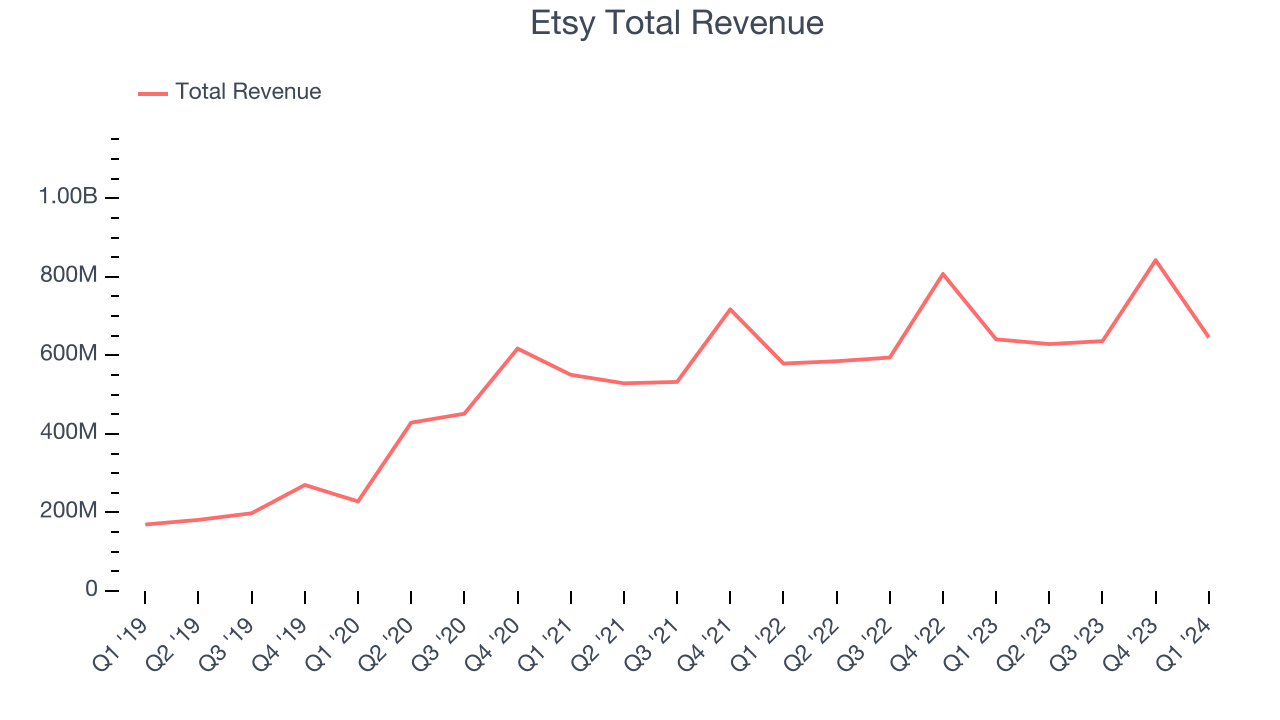
Ahead of the earnings results, analysts were projecting sales to grow 4.8% over the next 12 months.
Usage Growth
As an online marketplace, Etsy generates revenue growth by increasing both the number of buyers on its platform and the average order size in dollars.
Over the last two years, Etsy's active buyers, a key performance metric for the company, grew 2.9% annually to 96.39 million. This is one of the lowest rates of growth in the consumer internet sector.
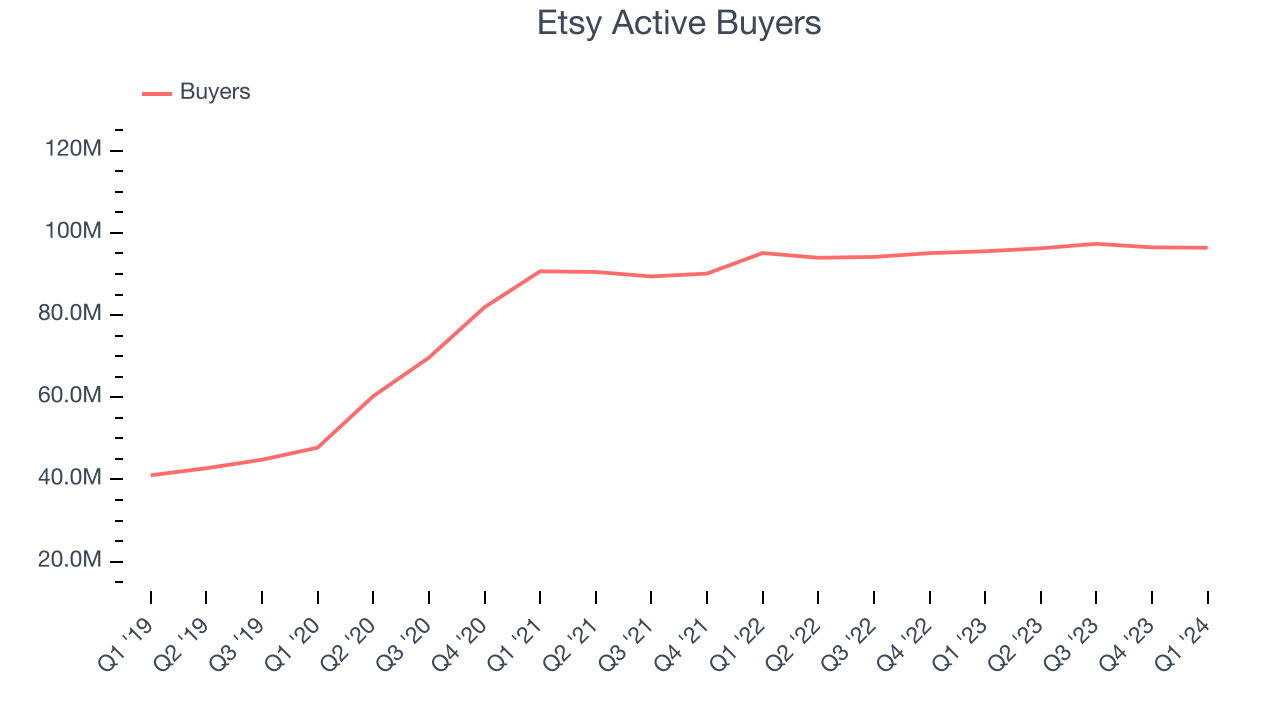
In Q1, Etsy added 866,000 active buyers, translating into 0.9% year-on-year growth.
Revenue Per Buyer
Average revenue per buyer (ARPB) is a critical metric to track for consumer internet businesses like Etsy because it measures how much the company earns in transaction fees from each buyer. Furthermore, ARPB gives us unique insights as it's a function of a user's average order size and Etsy's take rate, or "cut", on each order.
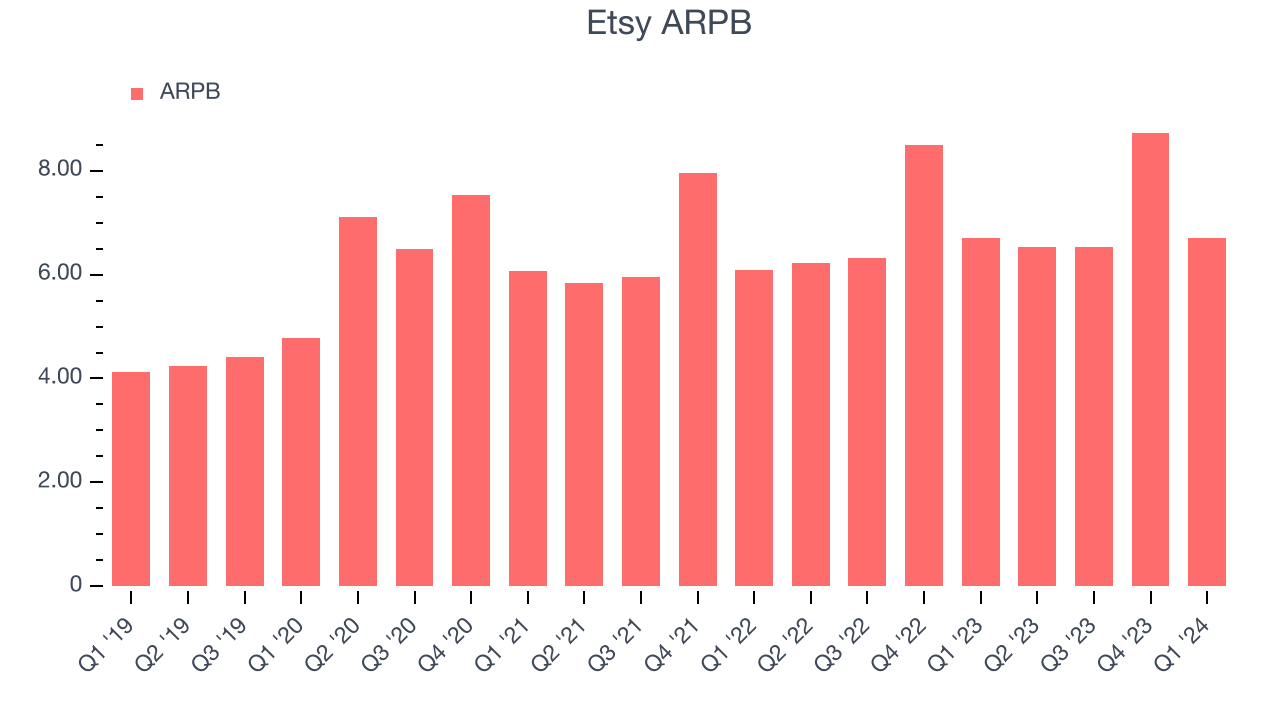
Etsy's ARPB growth has been decent over the last two years, averaging 5.1%. The company's ability to increase prices while growing its active buyers demonstrates the value of its platform. This quarter, ARPB declined 0.1% year on year to $6.70 per buyer.
Pricing Power
A company's gross profit margin has a major impact on its ability to exert pricing power, develop new products, and invest in marketing. These factors may ultimately determine the winner in a competitive market, making it a critical metric to track for the long-term investor.
Etsy's gross profit margin, which tells us how much money the company gets to keep after covering the base cost of its products and services, came in at 71% this quarter, up 1.5 percentage points year on year.
For online marketplaces like Etsy, these aforementioned costs typically include payment processing, hosting, and bandwidth fees in addition to the costs necessary to onboard buyers and sellers, such as identity verification. After paying for these expenses, Etsy had $0.71 for every $1 in revenue to invest in marketing, talent, and the development of new products and services.
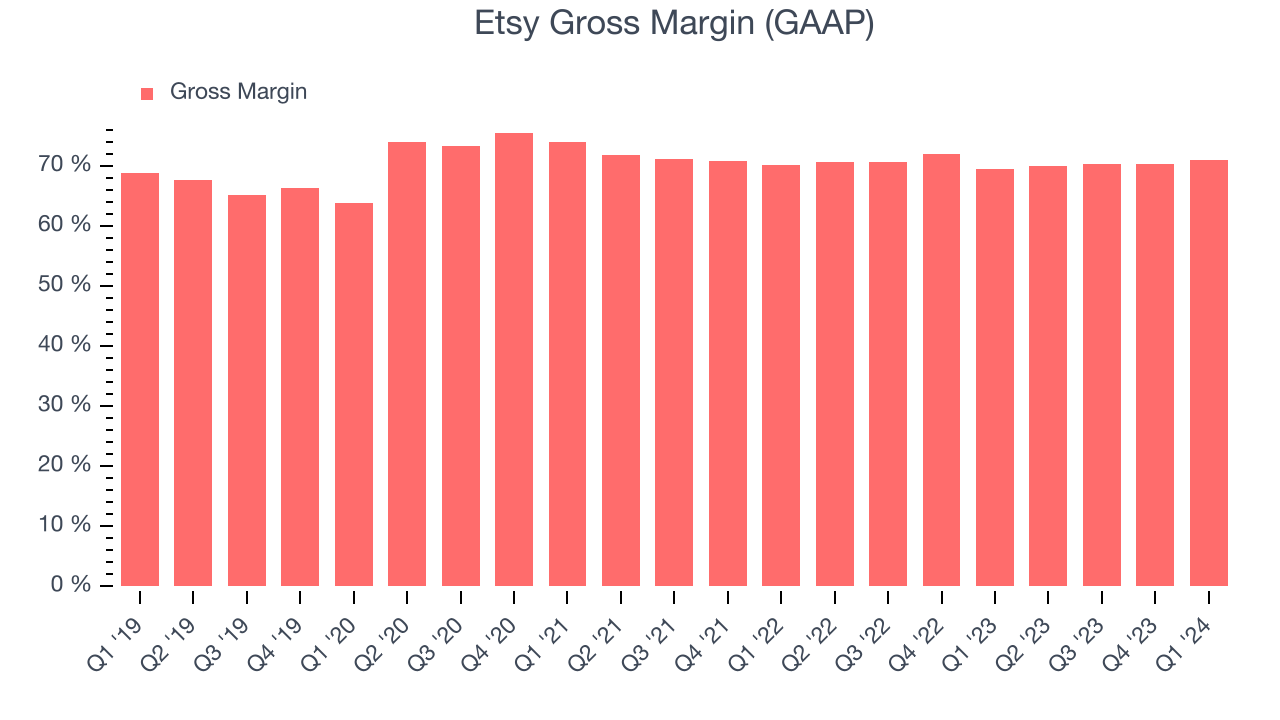
Etsy's gross margins have been stable over the past year, averaging 70.4%. These robust unit economics, driven by the company's asset-lite business model and strong pricing power, are higher than its peer group and allow Etsy to make more investments in product and marketing.
User Acquisition Efficiency
Unlike enterprise software that's typically sold by dedicated sales teams, consumer internet businesses like Etsy grow from a combination of product virality, paid advertisement, and incentives.
Etsy is efficient at acquiring new users, spending 39.7% of its gross profit on sales and marketing expenses over the last year. This level of efficiency indicates relatively solid competitive positioning, giving Etsy the freedom to invest its resources into new growth initiatives.
Profitability & Free Cash Flow
Investors frequently analyze operating income to understand a business's core profitability. Similar to operating income, adjusted EBITDA is the most common profitability metric for consumer internet companies because it removes various one-time or non-cash expenses, offering a more normalized view of a company's profit potential.
Etsy reported EBITDA of $167.9 million this quarter, resulting in a 26% margin. Additionally, Etsy has demonstrated extremely high profitability over the last four quarters, with average EBITDA margins of 27.3%.
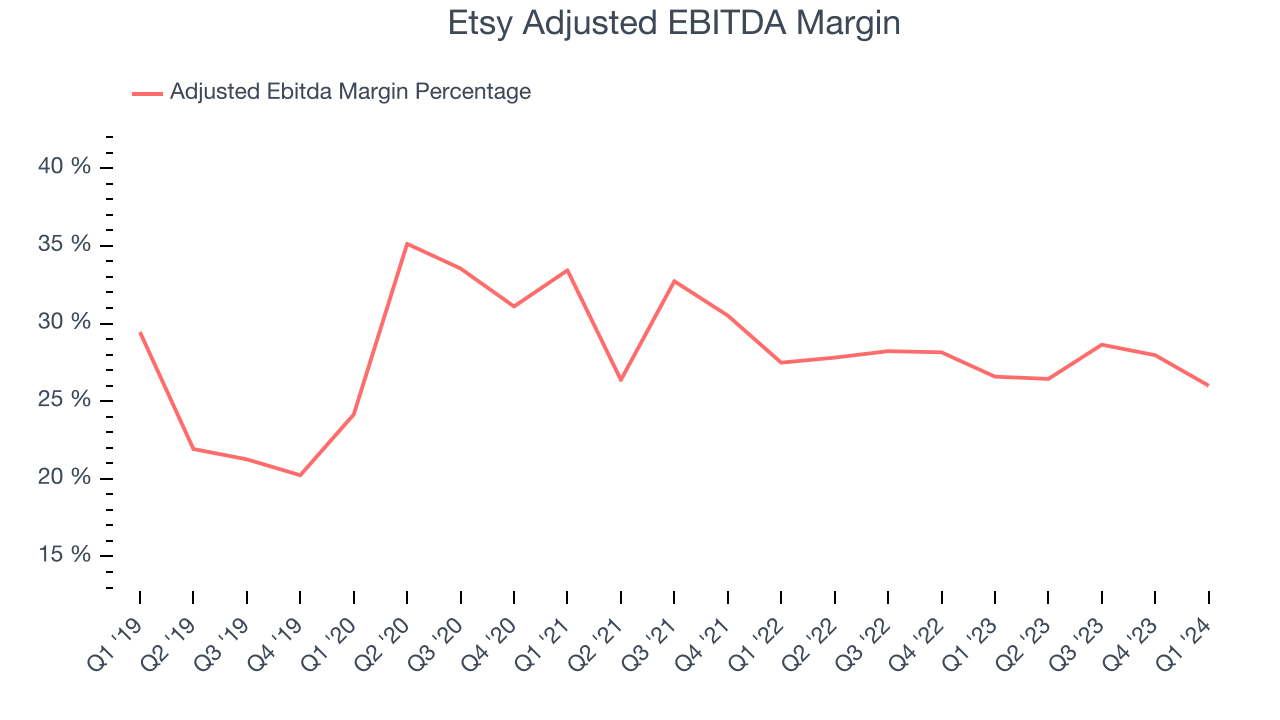
If you've followed StockStory for a while, you know that we emphasize free cash flow. Why, you ask? We believe that in the end, cash is king, and you can't use accounting profits to pay the bills. Etsy's free cash flow came in at $59.32 million in Q1, up 25.1% year on year.
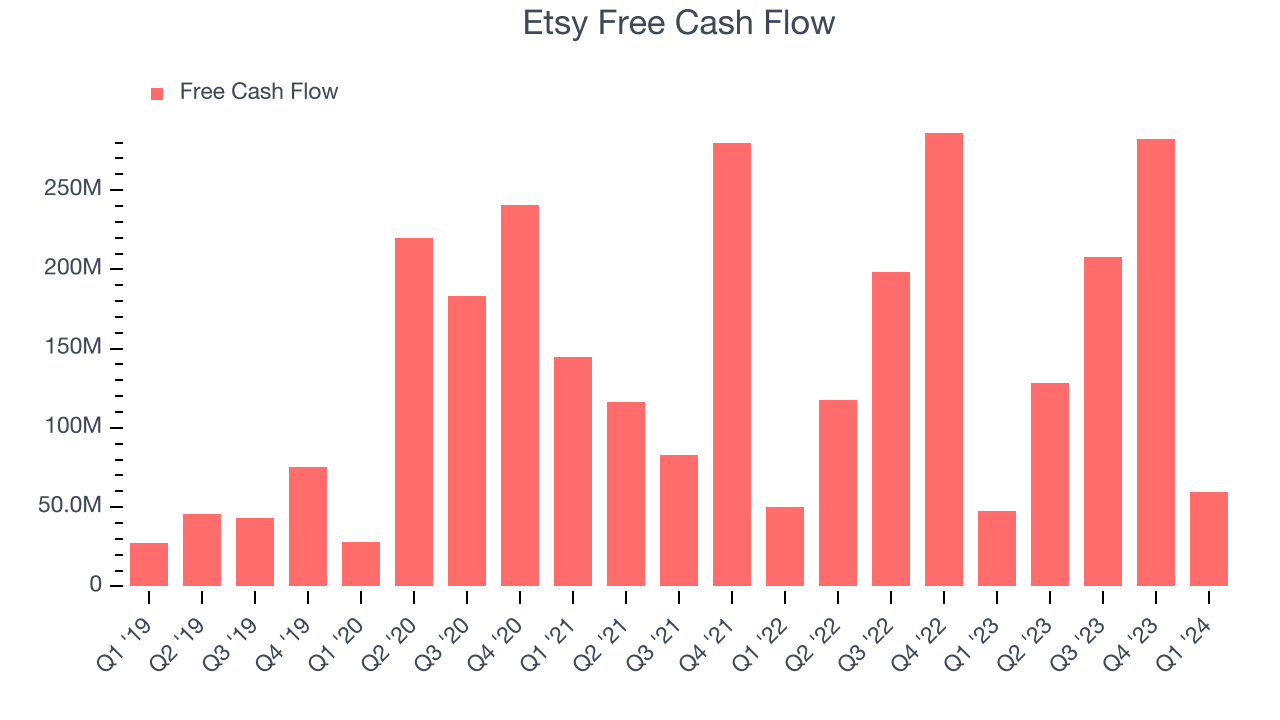
Etsy has generated $677.5 million in free cash flow over the last 12 months, an eye-popping 24.6% of revenue. This robust FCF margin stems from its asset-lite business model, scale advantages, and strong competitive positioning, giving it the option to return capital to shareholders or reinvest in its business while maintaining a healthy cash balance.
Balance Sheet Risk
Debt is a tool that can boost company returns but presents risks if used irresponsibly.
Etsy reported $1.04 billion of cash and $2.39 billion of debt on its balance sheet in the most recent quarter. As investors in high-quality companies, we primarily focus on two things: 1) that a company's debt level isn't too high and 2) that its interest payments are not excessively burdening the business.
With $751.9 million of EBITDA over the last 12 months, we view Etsy's 1.8x net-debt-to-EBITDA ratio as safe. We also see its $21.73 million of annual interest expenses as appropriate. The company's profits give it plenty of breathing room, allowing it to continue investing in new initiatives.
Key Takeaways from Etsy's Q1 Results
We struggled to find many strong positives in these results. Its revenue growth regrettably slowed as its gross merchandise sales and active buyers fell short of analysts' estimates. That was slightly offset by the company's better-than-expected take rate, showing it charged higher commissions to offset its worse-than-expected demand.
Etsy's management team noted that Q1 was a challenging environment for consumer discretionary products, which was a headwind to its growth. The company provided ambiguous guidance for the full year as well, spooking investors.
Overall, this was a tough quarter for Etsy. The company is down 15.5% on the results and currently trades at $58.97 per share.
Is Now The Time?
Etsy may have had a bad quarter, but investors should also consider its valuation and business qualities when assessing the investment opportunity.
We think Etsy is a solid business. Although its revenue growth has been a little slower over the last three years, its powerful free cash flow generation enables it to stay ahead of the competition through consistent reinvestment of profits. And while its active buyers have declined, its gross margins are a strong starting point for the overall profitability of the business.
At the moment, Etsy trades at 0.0x next 12 months EV-to-EBITDA. There are definitely things to like about Etsy and looking at the consumer internet landscape right now, it seems that the company trades at a pretty interesting price.
Wall Street analysts covering the company had a one-year price target of $80.78 per share right before these results (compared to the current share price of $58.97), implying they saw upside in buying Etsy in the short term.
To get the best start with StockStory check out our most recent Stock picks, and then sign up to our earnings alerts by adding companies to your watchlist here. We typically have the quarterly earnings results analyzed within seconds of the data being released, and especially for the companies reporting pre-market, this often gives investors the chance to react to the results before the market has fully absorbed the information.
